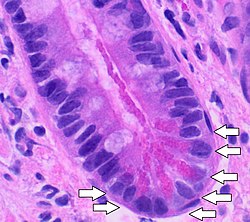
Back خلية بانيت Arabic Cèl·lula de Paneth Catalan Panethova buňka Czech Paneth-Zelle German Célula de Paneth Spanish سلول پانت Persian Cellule de Paneth French Célula de Paneth Galician תאי פאנט HE Cellule di Paneth Italian
This article needs more reliable medical references for verification or relies too heavily on primary sources. (April 2020) |  |
| Paneth cell | |
|---|---|
 Paneth cells, located at the base of the crypts of the small intestinal mucosa, and displaying bright red cytoplasmic granules. H&E stain. | |
| Details | |
| Location | Small intestine epithelium |
| Identifiers | |
| Latin | cellula panethensis |
| MeSH | D019879 |
| TH | H3.04.03.0.00017 |
| FMA | 62897 |
| Anatomical terms of microanatomy | |
Paneth cells are cells in the small intestine epithelium, alongside goblet cells, enterocytes, and enteroendocrine cells.[1] Some can also be found in the cecum and appendix. They are located below the intestinal stem cells in the intestinal glands (also called crypts of Lieberkühn) and the large eosinophilic refractile granules that occupy most of their cytoplasm.
When exposed to bacteria or bacterial antigens, Paneth cells secrete several anti-microbial compounds (notably defensins and lysozyme) that are known to be important in immunity and host-defense into the lumen of the intestinal gland, thereby contributing to maintenance of the gastrointestinal barrier by controlling the enteric bacteria. Therefore, Paneth cells play a role in the innate immune system.
Paneth cells are named after 19th-century pathologist Joseph Paneth.
- ^ Ibelgaufts H. "Go to Cells-Talk.com". Copewithcytokines.org. Retrieved 2016-09-17.